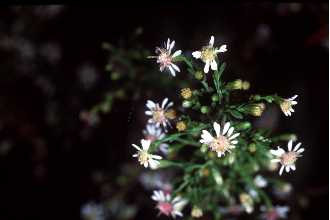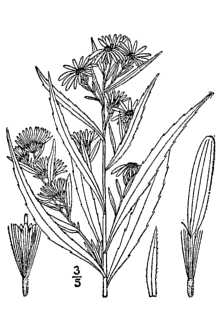Aster simplex Willd. var. estuarinus B. Boivin
Scientific Name: Aster simplex Willd. var. estuarinus B. Boivin

| General Information | |
|---|---|
| Usda Symbol | ASSIE |
| Group | Dicot |
| Life Cycle | Perennial |
| Growth Habits | Forb/herb |
| Native Locations | ASSIE |
Plant Guide
Alternative Name
panicled aster, Aster lanceolatus
Uses
Ethnobotanic: The dried and powdered plant was used as a salve on abrasions (Moerman 1998). A decoction of the plant was used to dress wounds (Ibid.). Smoke from the crushed blossoms was inhaled in the treatment of nosebleeds. Wildlife: White panicle aster is known for attracting butterflies and moths to areas where it is found growing. This is a good bee plant providing nectar in the autumn. Most species in this genus seem to be immune to the predications of rabbits (Thomas 1990).
Status
Please consult the Plants Web site and your State Department of Natural Resources for this plant’s current status, such as, state noxious status and wetland indicator values, Use soil moisture sensors to measure the soil moisture of Aster simplex Willd. var. estuarinus B. Boivin.,
Description
General: Aster family (Asteraceae). White panicle aster is a perennial growing up to two meters tall. The leaves are alternate, long, narrow, widest near the middle, and sometimes irregularly toothed along the edges, ranging up to six inches long (Ladd 1995). The flower heads are in an open, leafy, conical cluster at the top of the plant (Ibid.). The flowers are hermaphrodite (having both male and female organs) and are pollinated by bees, butterflies, flies, beetles and moths. Distribution: White panicle aster ranges from Maine and south to South Carolina, west Texas and North Dakota. For current distribution, please consult the Plant profile page for this species on the PLANTS Web site. Robert Mohlenbrock USDA, NRCS, Wetland Sciences Institute @ PLANTS
Adaptation
This plant is common throughout the tallgrass region in wet prairies, low wet depressions and along streams (Ladd 1995). It requires well-drained soil and prefers sandy, loamy and clay soils. This species can grow on nutritionally poor soil but prefers rich soil. It grows well in a sunny location and can succeed in partial shade.
Establishment
Propagation by Seed: Seeds should be sown fresh in the fall or spring (Heuser 1997). Pre-chill spring sown seeds to improve germination (Ibid.). When the seedlings are large enough to handle, place them into individual pots and plant them out in the summer. Division of this species should be done in the spring or autumn. Large divisions can be planted into their permanent positions whereas smaller clumps should be kept in a cold frame until they are growing well. Cultivars, Improved and Selected Materials (and area of origin) Occasionally available through native plant nurseries within its range. Contact your local Natural Resources Conservation Service (formerly Soil Conservation Service) office for more information. Look in the phone book under ”United States Government.” The Natural Resources
Conservation
Service will be listed under the subheading “Department of Agriculture.”
References
Gleason, H.A. & A. Cronquist 1991. Manual of the vascular plants of northeastern United States and adjacent Canada. 2nd ed. The New York Botanical Garden, Bronx, New York. Heuser, C.W. 1997. The complete book of plant propagation. The Taunton Press, Newtown, Connecticut. Huxley, A. 1992. The new RHS dictionary of gardening. MacMillan Press, New York, New York. Ladd, D. 1995. Tallgrass prairie wildflowers: a falcon field guide. Falcon Press Publishing Company, Helena, Montana. Moerman, D. 1998. Native American ethnobotany. Timber Press, Portland, Oregon. Thomas, G.S. 1990. Perennial garden plants. J.M. Dent & Sons, London

